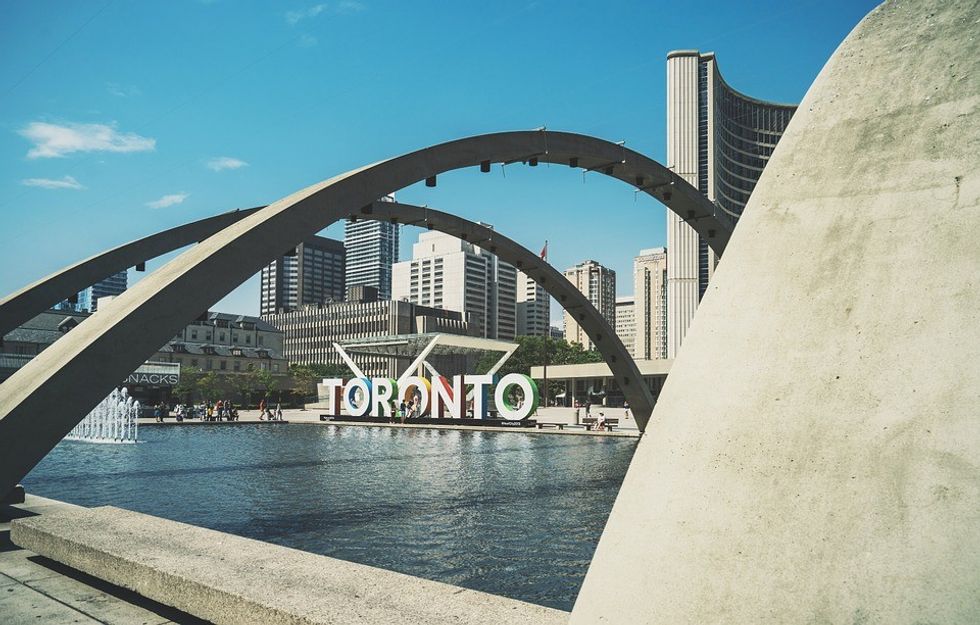Find a safe place for the sellers to be so the home is empty. Get a photographer, inspector, and stager in without breaking physical distancing measures. Repurpose a 'sold sign' from a previous property because the sign company has shut down. Set up a showing that includes disclaimers about COVID-19 symptoms. Offer sanitizer and masks. Wipe down anything a buyer touches. Send agreements electronically. Make Zoom calls to go over details. Close virtually.
This is what Bosley Real Estate Ltd. broker Kate Watson’s working life looks like just one month after the province started shutting down.
And the uncertainties she and her clients face are a microcosm of what is playing out in the real estate landscape in Toronto.
Sales in April are down about 70% compared to the same time last year, according to data from the Toronto Regional Real Estate Board (TRREB).
The stats on sales of newly-built homes are only available for March, according to the Building Industry and Land Development Association (BILD). They show strong activity, but these numbers reflect activity that generally happened before the stay-home orders and the province's move to put a hold on new construction that is not near completion.
About 75% of April rents have been fully paid, according to a survey by the Federation of Rental-Housing Providers (FRPO). Expectations for May and beyond are worse.
Different from other periods of turmoil, nearly everything has gone into a deep freeze, industry observers say. During the 2008 financial crisis, for instance, there were many listings but few buyers. Now, there is little activity on either side, so both supply and demand have plummeted.
As for whether Toronto will see prices come down after years of skyrocketing values on homes, industry observers say that, right now, they are seeing prices either hold steady or soften only slightly.
But when it comes to long-term forecasting, most agree that it depends on too many unknown factors, especially how long physical distancing will continue, and how hard the forced closures will hit job losses and the economy overall.
Behind the Face Mask
“At the onset of this pandemic, TRREB urgently and strongly advised our 56,000 realtor members to refrain from face-to-face real estate practices as much as practicable during the (Ontario) state of emergency,” says Michael Collins, TRREB President.
Among the new tools TRREB has introduced to help people view properties is one that allows TRREB members to live-stream open houses on their listings so that interested buyers can join the salesperson for virtual open houses in real time as they walk through the property, present its features, and answer questions, Collins says.
But it’s the Real Estate Council of Ontario (RECO) that’s the organization behind the enforcement of the current rules that real estate salespeople, brokers, and brokerages must follow in the province. These include a bevy of new limitations both buyers and sellers must work around.
“Buyers entering the market can expect such physical distancing measures as: COVID-19 and vulnerability screenings, limited physical access to properties, new protocols and heightened safety and sanitation measures. Buyers can also anticipate an increased reliance on technology and digital media throughout the home-buying process. This may include anything from video-conferencing with their salesperson, showcasing of homes through virtual home tours and video walk-throughs to electronic document transfers for such things as: contracts and property information, and use of electronic signature tools for finalizing agreements, whenever possible,” the organization says.
Sotheby’s, for instance, moved its entire operation from a physical to a virtual environment in record time, says Don Kottick, president and CEO of Sotheby's International Realty Canada.
The company banned open houses and implemented protocols for buyers, sellers and third parties, such as photographers and inspectors. Virtual tours were already in place with agents trained in how to use the technology.
Like others, the company saw a steady decline in activity since social distancing started in March. But they are actually starting to see an uptick in activity, says Kottick.
“We predicted a bit of normalization,” as the market got used to the virtual environment, he says.
“People will always need to buy and sell.”
Of course, the pandemic has not only affected the process of buying and selling a home, but also the outlook for the industry as a whole.
“Traditionally, the housing market has been driven by population growth, which is strongly linked to economic growth and job opportunities. On top of this, the cost of borrowing, in terms of mortgage rates, is a key determinant as well,” TRREB’s Collins says.
However, he adds, “the current situation has not been driven by traditional economic drivers. Instead, health concerns have necessitated strict social distancing measures. So, while economic drivers will be a key consideration as we move into recovery, the timing of recovery will be dictated by the trajectory of COVID-19 cases.” A recent best-case forecast from the Public Health Agency of Canada suggests that cases will peak in the spring and start to go lower through the summer and tail off in the fall.
But a second wave of infections could change that outlook. And could keep houses closed even longer.
From ‘On Fire’ to Frozen
Shawn Zigelstein, broker at Royal LePage and team leader of Team Zold, says "the first two weeks of March were absolutely on fire,” with multiple offers and average price going through the roof.
“And then the shutdown hit.”
Royal LePage released a forecast on April 14, suggesting a best-case scenario that home prices could grow 1% year-over-year by the end of 2020 if stay-home restrictions are eased later this spring. However, if business activity continues to be restricted until fall, the company expects prices to drop about 3%. This compares to a pre-pandemic forecast of a national price increase of 3.2% by the end of 2020.
“Due to COVID-19, expected price growth has been revised down almost 70 per cent,” compared to the company’s earlier scenario.
But it depends on what type of home people are looking at, Zigelstein says. For people with stable jobs, who are renting now, they now may have the ability to jump into the market. Lower income earners, who can usually only afford lower-priced homes, such as condos, are typically the ones who have lost jobs, he says.
As such, the mid-range market will likely be strong, with low interest rates. So, for instance, move-up buyers may free up town houses and semi-detached homes.
The upper end may take a bit of hit, Zigelstein adds. Those buyers may have significant stock-market investments that may drop, or could be business owners who have had shutdowns.
The Financing and Re-Financing Dance
Mortgage agent Joanna Lang says she is seeing lenders becoming more cautious.
“We are seeing less exceptions … over qualifying criteria,” says the managing partner at Outline Financial.
“If a client got to the point of file complete… a majority of lenders are allowing them to close.” But with new applications, banks want to see that people have stable jobs, with recent pay stubs and a letter from the employer.
RELATED: ‘Unprecedented’ Number of Canadians Looking to Refinance Mortgages: Report
“The area where it’s the toughest… is refinancing,” where she says she is seeing people who are not working are unable to refinance mortgages. She is advising clients to ask for deferrals, but adds that they will have the interest on skipped payments added to the principle. She has also seen people be unable to draw equity from their homes.
Those who need to turn to alternative lenders will find it more expensive, she adds.
As for lenders backing larger developments, “the deals have stopped cold,” says Graham Rawlinson, partner and co-head of real estate at Torys LLP.
However, he does not see investor interest drying up long-term, especially in areas such as multi-family buildings and seniors housing that are seen as recession-proof.
“A lot of people have money" and will be looking to put it somewhere, he says.
We'll Take 'Price' for $1,000,000, Alex
Prices have been steady compared with last year in the resale market at this point because this is not like a regular recession, where there is too much on the market and fewer people can afford to buy, says Benjamin Tal, deputy chief economist at CIBC. “This time the market is frozen… Nobody is selling and nobody is buying.”
The question is, “What will happen to the market when we go back to semi-normal,” which he anticipates will be 2-3 months from now.
“I suggest that given the panic, given the fear, given the uncertainty …. we will see reduced demand and it’s not unthinkable that we will start seeing… prices falling in the summer or into the fall.”
The unemployment rate was 5.5% before crisis. Now, it’s about 13%, he says.
When we get to a new normal, something he calls a “recessionary recovery,” about a year from now, it may be about 7%, he anticipates. At that point, the government aid put in place may have come to an end and that is when we will see the more permanent effect on the economy and on people’s ability to afford homes.
He sees the demand for mortgages and for real estate transactions going down longer-term.
As someone who uses inventory as a measure of the market, John Pasalis, president of Realosophy Realty, doesn't see downward pressure on prices as he tracks available listings. Not in the short-term, at least.
“We are unlikely to see a big spike in inventory. That’s really what puts downward pressure on prices. Even in a recession it’s not the job losses themselves that put downward pressure on prices. It’s that because of the job losses people sell their home and you have more inventory than demand.”
Inventory stats tell you which way it’s heading, he says. “If you have 4-6 months’ inventory, it means prices should stay relatively flat. If we’re above 6 months, it means prices will probably fall and if we’re below that, it means prices are going up.
“If inventory is constantly increasing, it means the market is slamming on the brakes. I’m starting to see over the past couple of weeks, (inventory is) hitting cruise control, bouncing around 4 months of inventory.”
History Lessons
For those who are not just simply trying to survive the daily challenges this crisis is throwing at everyone, from essential workers to those trying to figure out their next meal, the questions of how to map out next steps usual means turning to lessons from previous, similar events.
But with the word “unprecedented” being thrown around constantly is there any comparative event we can use to plot a trajectory?
“It is difficult to draw lessons from any past event or period, such as the Great Depression in the 1930s,” says Robin Wiebe, senior economist at the Conference Board of Canada, “as we do not have adequate data to do that.”
Wiebe did look at available data since the 1960s on housing starts and average Canadian resale prices and found that in three significant downturns – in the early 1980s and 1990s and in the financial crisis of 2008 – the country’s economy, or GDP, fell about 2% to 4% on a year-over-year basis. By comparison, in March alone, Canada's GDP dropped 9% (the largest single-month drop on record), leading Stats Can tp predict an overall decline in GDP of 2.6% in the first quarter of 2020.
During the three episodes of significant downturn Wiebe studied, housing starts fell an average of 126,000 units from their pre-recession peak.
Since starts peaked at about 225,700 units in the first quarter of 2018, he says, a drop of this magnitude would put the trough of housing starts at just under 100,000 units.
Resale prices are even more sensitive to GDP growth fluctuations, he says. They tend to drop even if GDP growth slows; they don’t need it to turn negative to drop. This happened in mid-1995, when Canada’s average resale price fell about 2% year-over-year as GDP growth eased to 0.6%. In the financial crisis of 2008, the average resale price decline was more than 3%.
The Conference Board is currently forecasting an annual GDP decline in the mid-4% range.
So You're Saying There's Still a Crisis?
The Building Industry and Land Development Association (BILD) today released numbers about construction on new buildings.
There were 3,730 total new home sales in March in the GTA, which was up 67 per cent from the same time last year, and 7% above the 10-year average, according to Altus Group, the company that supplies BILD with its market intelligence.
Broken down, there were 2,840 condo units sold, up 108% from March last year. There were 890 single-family home sales, including detached and semi-detached houses and townhouses, up 2% from last March.
But those numbers reflect pre-lockdown activity, says David Wilkes, President and CEO of BILD.
One of the big things those numbers show is the way there just wasn’t enough new housing to meet the demand, which meant prices continued to climb, he says. “Based on numbers prior to the freeze, we needed 50,000 new units to be built a year to supply demand and were building 38,000.”
The province froze any new building that was not near completion on April 3. The questions Wilkes identifies as the most important to answer once new building is allowed to resume are:
- As immigration is a big driver of growth and demand for housing in Toronto, what happens to that group in the near future, and long-term?
- While construction was allowed to continue on buildings that had a footing, what didn’t continue was the up-front work, like getting the earth ready for development, laying pipes and sewers, building roads, etc. When will the disruption to that supply chain get back to normal?
- Will there be a rethink of the things that previously added cost and stifled new construction, such as the way developments are taxed?
- Will consumers have enough confidence in their jobs and finances to buy new homes?
BILD members also build purpose-built rental housing. Speaking of which...
The Rent is Still Too Damn High
A survey of landlords suggests about 76% of residents made a full rent payment for April, says Tony Irwin, president and CEO of the Federation of Rental-Housing Providers (FRPO).
Numbers released last week also showed about 7% made a partial payment. That leaves about 15% of people who had not paid their April rent. And the organization is bracing for worse numbers in May.
That means landlords have less capital to pay for maintaining buildings, paying for the extra cleaning needed in a pandemic and the ability to offer tenants interest-free payment plans through the crisis, he says. The organization is calling for the government to provide direct assistance for the purpose of paying rent.
But longer-term, a knock-on effect could be that developers may not be able to, or may not want to, take the risk of building new purpose-built rental buildings at a time when people with potentially lower incomes through a recession may not be able to afford to buy a home, he adds.
RELATED: Toronto Renters Could See Some Relief in the Post-COVID Market
CAPREIT is one of Canada’s largest residential landlords and also has a presence in Europe.
“Everything is a function of how long this goes on for. If this goes on longer, you can expect greater economic fallout, says Mark Kenney, president and CEO. If there’s greater economic fallout, then the viability of purpose-built rental sites goes way down.”
Sites are being built today with assumptions of $4- and $5-a-square-foot monthly rents, he says. “You need those kinds of rents because of how expensive it is to build now to make it viable.”
“We do expect to see a cancellation of projects if this goes on.”
Kenney also says what happens in the condo market could play into what happens with the rental market as a whole. “If this does disrupt the Toronto real estate market and condos start getting sold in any sort of large numbers, we know that those current condos are the rental supply that Toronto has had over the last 10 years and they could go into owner-occupier hands.” In other words, if owners cannot afford an investment property, they may no longer be available for rent.
“Over 80% of apartment ownership is in small-owner hands” of 1-2 units. “REITS and corps make up less than 5% of rental supply in Canada,” he says, adding that about 35% of the population lives in a rental home.
Many small owners are not buying investment condos for the rent but because they expect the property to increase in value. “Folks would buy a condo and barely be able to cover the mortgage and condo fees and taxes, but would treat it as an investment because it was going up in value.”
If that changes, “You could see not just a change in ownership but a slowing in the condo market if there’s a real jolt to the economy.”
But these are just potential scenarios and it is very early days to predict anything like this, he says. He adds that large investors, such as pension funds, are not pulling out of purpose-built rental at this point. CAPREIT’s stock dropped about 35% from the beginning of March to its lowest point on March 23, but has since rebounded to recover approximately half of that loss so far.
‘We’ve Got to Survive This’
“What we’ve got on our hands is like a combination of the Spanish Flu and the Great Depression,” says Richard Lyall, president of RESCON, an association of residential builders in Ontario.
“Many models can’t handle the scale of what we are looking at… and forecasting is virtually impossible.”
He anticipates that “We are going to be in this (pandemic) phase for 1-2 years and … I think a recession will run well into 2021-2022.” He sees factors like a looming credit crunch, potential inflation in a couple of years and defined benefit pension plans “getting smashed” as factors that will contribute to a difficult return to a humming economy.
But he doesn’t see a real estate market crash because the housing market has been so tight.
He also doesn’t expect a threat to the supply chain of materials to the construction industry, partly because Chinese factories are getting back up and running. “Close to 20% of parts that go into construction-related products come out of China.” And concrete, timber and steel can be sourced in Canada.
One positive he sees in this is an opportunity to update and innovate processes to make development more efficient, for instance updating “antiquated zoning systems,” digitizing permitting approvals processes and doing virtual inspections. He also sees the potential for changes in home designs, such as creating bathrooms that are home diagnostic centres or more home office spaces or physical education centres in homes. “But that’s way down the road.”
“We’ve got to survive this thing first.”
Paying the Piper
Not only are the federal and provincial governments racking up massive deficits spending money on emergency measures to help individuals, businesses and the health system, but Toronto itself is losing money.
A best-case scenario for the City is a projected total pressure of $1.5 billion for 2020 due to various factors including lost revenue from the TTC and property tax deferrals. This pressure may be driven higher if there is a significant real estate market impact, the physical distancing measures are extended beyond 12 weeks, or there continue to be additional waves of COVID-19 throughout the remainder of the year, says spokesperson Lawvin Hadisi of Mayor John Tory’s office.
RELATED: Toronto Could Face Budget Shortfall of Nearly $2.8 Billion Because of COVID-19: Tory
“The City cannot run a deficit and the idea of raising taxes or cutting services would further hurt our residents and businesses. That is why the Mayor is relying on both the federal and provincial governments for financial relief.”
As for broker Kate Watson, who continues to try to navigate the new rules COVID-19 has brought to the real estate industry as she prepares empty houses for people to visit through screens, she offers a uniquely pragmatic outlook, reminding us that “It seems like it’s been forever, but we have to remember it’s only been a few weeks.”























